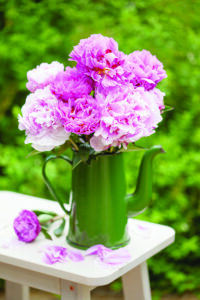
Peonies are a popular wedding flower for both their scent and their looks, and they stand for both a happy life and a happy marriage.
Peonies have long been a garden favorite. In fact, some peony plants themselves have long been a favorite in the same garden for up to 100 years! Beautiful, fragrant and with hardy varieties, once a peony settles in, it can become a long-term piece of a home’s landscape.
Popular for weddings and popular for cut gardens, they come in a variety of colors and shapes.
Shades can be pink, red, and white, as well as orange and yellow, which are the rarest colors.
They even vary in scent. Some can smell similar to roses while others have a citrus or lemon scent.
Of the three types, herbaceous peonies are the most common.
They take up less space in your garden, and at the end of the season before your garden retires for the fall, you cut them all the way to the ground.
In the spring you can buy them potted, with the red stems already sticking out for the better chance at flowers the same year.
They also come as tubers, which you’ll want to soak in water a bit and plant after the ground is dry and warming up.
Because of the size of the flowers compared to the delicate stems, you may want to give them extra support by lightly staking them.
To forgo staking, you could try tree peonies, similar to a hardy shrub.
The flowers also tend to stay around a little longer.
You also get to skip the cutting back as the stalks stick around through the winter and regrow the following year.
Lastly, there are intersectional or Itoh (named after the Japanese horticulturalist, Toichi Itoh, who hybridized them) which are a mix of the other two types.
They have large and fragrant blooms, are a little tougher to the cold and also aren’t as large in footprint as the tree peonies.
You’ll want to cut this type all the way back as well.
There are also different types of the blooms themselves.
As classified by the American Peony Society, the blooms are either anemone, single, Japanese, semi-double, double, or bomb.
The blooms can surely all look quite different, as some of the bloom types are open with all the flower’s organs showing like the Japanese or single, while others just show off frilly petals, like the bomb variety.
With so many choices, you don’t have to stop at one type of peony.
Try a few varieties with differing bloom times and enjoy a lively flower show throughout the spring and summer.
Indeed, they have a reputation of outliving the person who planted them, but it does take them a bit to get going.
It can take up to three years before you have a truly thriving plant reaching full potential.
When planting, keep in mind that peonies are as pretty as they are pushy so plan accordingly.
To initially place your plant, dig a large hole and loosen up the soil well to promote healthy growth in the future.
You don’t have to dig deep, just about 2-3 inches. Space them out from your other plants, especially other peonies.
Proper space keeps your plant blooming regularly with full blooms and clear of fungus.
Healthy growth will also promote strong stems to hold up the large blooms.
After a handful of years, it’s likely that you’ll want to divide and replant them in the fall.
This would also be a good time to swap around with friends who also have healthy peony plants.
As for deadheading, it’s not necessary as it won’t encourage new blooms in the same year, but it does look a little cleaner to remove the browned and wilted blooms.
One more thing to keep in mind on peonies is they can attract ants.
While to many they may be considered a foe, or at least a nuisance, to peonies, ants are friends.
Ants enjoy sucking up the nectar of the blooms and they keep away more harmful insects like thrips by doing so.
An old farmer’s tale was that the ants were necessary to encourage blooms to open.
While it’s not true that peonies need the ants for that reason, they come for the nectar and leave when depleted so there’s also no reason to panic about removing them either.
If they are there when you go to snip some beautiful blooms, just lightly shake them upside down so you don’t bring any guests into your house.
Peonies are a popular wedding flower for both their scent and their looks, and they stand for both a happy life and a happy marriage.
Putting them in your landscape could mean a happy garden too.



